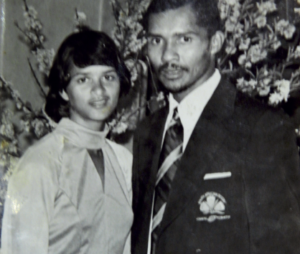In the first instalment of SA Rugby magazine’s series on black rugby legends, GARY BOSHOFF looked back on the career of former Boland and Saru captain Randy ‘Yster’ Marinus.
EARLY LIFE
Randy Marinus epitomises the history of black rugby as he represented both sides of the divide – the South African Rugby Federation (Sarf) and the South African Rugby Union (Saru) – during the volatile years that were the 1970s and ’80s.
As a high-school pupil in the late-70s and a student at the University of the Western Cape (UWC) in the early-80s, he became my role model and inspiration.
Marinus was born in Paarl in 1956, the middle child of a family of six brothers and three sisters. He grew up in Dwars Street, Paarl North, but like so many families had to relocate to Paarl East after the promulgation of the Group Areas Act of 1966.
Randy has fond memories of his father, Sap, who was well-known in the local community as a judo master.
‘My friends and I would accompany him to the Paarl mountains where he would train with judo enthusiasts,’ he recalls. ‘When I started to play rugby, my wife Juliet would take me to the same mountains where I would train.’
Marinus attended LK Zeeman Primary School and later, when they moved house, Ebenezer Primary. He did not play rugby in primary school – ‘I was too fat’ – and instead excelled in athletics, with notable achievements in shotput and javelin. Sadly, he lost his father at the tender age of 11 and realised he had to help his mother with his siblings.
Instead of attending high school he opted to find work and support the household.
This was the life-changing event that led to the development of Marinus’ distinctive character and later made him stand out as a leader; respected by his fellow players and the community.

RUGBY CAREER
At 16, Marinus joined Gardens RFC where his brother Glen was already a regular in the 1st XV. Marinus had a brief stint in Johannesburg as a 17-year-old when he went there for work.
In 1974, he played in the 1st XV of the Falcons RFC, who were competing for supremacy in the Transvaal RFU (Saru) with All Blacks RFC.
He returned to Paarl the same year and was selected for the Proteas (Sarf) side to play the touring All Blacks in 1976 in Goodwood, Cape Town. Marinus was just 19 when he donned the Proteas jersey for the first time and had to face the mighty All Blacks. He describes this match as one of the highlights of his rugby career. The Proteas held their own against an impressive All Blacks side that featured captain Andy Leslie, Laurie Mains, Ken Stewart, Laurie Knight, Sid Going and the famous Maori front rower Billy Bush. Though they lost 25-3, the team was lauded by the famous New Zealand rugby journalist Terry McLean in his book Goodbye to Glory: The 1976 All Black tour of South Africa. ‘Randy Marinus on the side of the scrum was quite remarkably quick,’ he wrote.
The following year, Marinus was invited to the Springbok trials in Pretoria and played alongside the likes of the famous Northern Transvaal captain Thys Lourens, Nick Mallett, Louis Moolman and Daan du Plessis.
However, the experience was not all positive. He sensed that he and his fellow ‘black trialists’ were used as ‘window dressing’ in preparation for the pending visit of a World XV.
This was after the 1976 Soweto riots and political awareness among oppressed communities increased throughout South Africa. His disillusionment grew when he returned to Paarl and represented the Paarl XV in the new ‘multi-racial’ rugby competitions (black teams were allowed to play against white teams, but teams were not allowed to be mixed).
Ultimately, it became unbearable and with the help of his brother-in-law, Aubrey Minnaar, a student at UCT, they left the Federation and joined the Wellington Rugby Union, an affiliate of Saru. He was 22.
Marinus went on to become one of the most decorated Saru players, having been selected for the side from 1982 to ’85. The last two years he was captain, which he describes as his greatest achievement.
‘I rate Clive Thomas, the famous Tygerberg eighthman, as the best forward I ever played against; he was a very tough but skilful player,’ says Marinus. ‘The two Nobles [who donned the Saru jersey in the early-80s] were the best midfielders I shared a rugby field with [Gabriel played for Somerset Board and later for Tygerberg RFU, while Christie played for the Boland RFU].’
Internationally, Marinus rates All Blacks great Murray Mexted and Roger Uttley (England and 1974 British Lions) as the best eighthman and flank forward respectively of his time.
LIFE AFTER RUGBY
Marinus turns 60 this year and is about to retire from his job at HG Molenaar Engineers in Paarl – after 43 years. He proudly says he gradually worked himself up in the business and qualified as a boiler maker. He still has his wife Juliet beside him, supporting him and sharing in his legacy and a life together filled with good memories. He still stays active by cycling and running in the beautiful Paarl Valley.
What struck me most about Marinus is his effervescence and positive attitude and the passion and love for rugby that still radiates from his eyes. Together with other former Saru players, he is positive about reviving interest in and reclaiming the inheritance of the non-racial era of Saru rugby and the players it produced.
For me, and his loyal friends and fans, Yster is a true legend and a ‘Giant’ (his other nickname) of the game.
– This article first appeared in the April 2017 issue of SA Rugby magazine.





